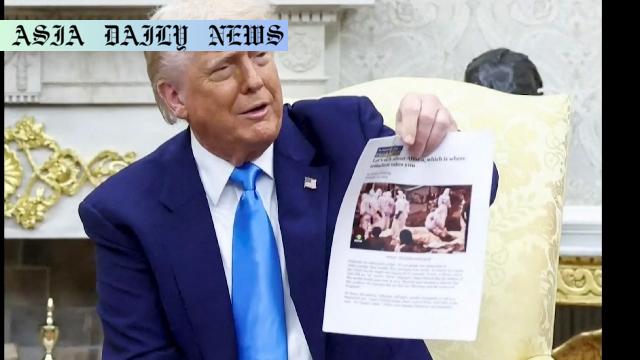Misinformation: Reuters debunks Trump’s use of a DRC image to falsely claim white killings in South Africa during Oval Office meeting.
Misinformation used by Trump during a meeting was exposed.
He mistakenly presented an image from the DRC for South Africa.
Reuters clarified the image origin as a mass burial in DRC.
Journalist expressed shock at the improper use of their video.
The White House abstained from commenting on the allegations.

Shocking Case of Misinformation: Trump, the DRC, and South African Claims
Background to the Incident
On Wednesday, during an Oval Office meeting with South African President Cyril Ramaphosa, former U.S. President Donald Trump presented materials that he claimed were evidence of mass killings of white farmers in South Africa. Among these materials was a striking image that Trump held up in front of the media and President Ramaphosa. However, Reuters, a respected global news agency, has since debunked his claims, revealing that the image Trump showcased during the meeting was not from South Africa but from the Democratic Republic of Congo (DRC).
According to Reuters, the image in question was not evidence of violence against white South African farmers but was instead a screenshot from a video they had published in February. The video captured a mass burial following an attack by anti-government rebels in the DRC. Despite the video originating from a credible source, an American conservative online outlet reportedly misused the screenshot and associated it with narratives of persecution and killings of white minorities in South Africa. This inaccurate portrayal added fuel to Trump’s unfounded claims.
The Impact of Misrepresentation
This incident highlights the dangerous implications of using misinformation, particularly when it originates from a position of such political authority. The misappropriation of the DRC image illustrates how easily media content can be distorted and misused. The journalist who captured the video expressed shock and disappointment upon discovering that Trump had used their image out of context. They remarked on the gravity of the situation, emphasizing the damaging consequences of distorting facts to fit pre-existing narratives.
In a globalized world where sensitive topics such as race and violence hold significant weight, such misinterpretations not only mislead but also perpetuate harmful stereotypes and fuel socio-political tensions. For South Africa, the claim of widespread violence against white farmers has long been a point of controversy, often intermingled with political rhetoric. By tying misleading media to this issue, Trump inadvertently added another layer of complexity to an already polarizing topic.
Reuters’ Expose and the Role of the Media
Reuters deserves commendation for quickly debunking the incorrect association of the image with South Africa. Their thorough investigation reaffirms the crucial role of credible journalism in upholding the truth. By clarifying that the video was filmed in the DRC and capturing the journalist’s perspective, Reuters demonstrated a commitment to transparency and accountability in media reporting.
This case also sheds light on the responsibilities of global leaders to verify the accuracy of their claims. Information, especially when presented in pivotal dialogues between nations, must be sourced accurately to foster meaningful discourse and trust. The absence of accountability in this situation raises vital questions about the credibility and ethics surrounding information dissemination in high-stake scenarios.
Conclusion: Lessons Learned
The use of misinformation in this instance serves as a cautionary tale about the perils of unverified narratives in the digital age. From journalists to policymakers to everyday citizens, the ability to discern credible information from distortions remains critical. This incident underscores the urgency of strengthening media literacy and ensuring the ethical use of information by those in power.
As is evident, inaccurate portrayals of sensitive topics can have widespread ramifications, including stoking racial tensions and misleading public opinion. While Reuters has restored some measure of truth to the situation, the broader lesson lies in the importance of vigilance, accountability, and integrity in information sharing.



Commentary
The Danger of Misusing Media Content
The improper use of media, especially when perpetuated by influential figures like a U.S. president, carries significant consequences. It exemplifies the dangers of spreading misinformation without conducting due diligence. In our digital world, misrepresentation can travel at the speed of a click, leaving countless individuals vulnerable to false narratives. The fact that an image from the Democratic Republic of Congo (DRC) was misused to support a completely unrelated claim about South Africa is not just troubling but highlights the critical importance of media accuracy and ethical leadership.
Political Agendas and Media Manipulation
One key takeaway from this incident is the potential for personal or political agendas to distort facts. When a narrative is crafted without substantiation, it inherently weakens credibility and trust between nations as well as between leaders and their people. The political climate often amplifies the dangers of misrepresentation, as information is weaponized to polarize or rally support. In such situations, those in power have a responsibility to ensure that their claims are factually sound before presenting information in such a prominent setting.
The Role of Journalism: A Beacon for Accountability
This episode serves as a stark reminder of why credible journalism remains indispensable in a world fraught with misinformation. Reuters’ swift action to expose the truth demonstrates the power of reputable media outlets to hold influential figures accountable. It also underscores how crucial factual reporting is in preserving the integrity of sensitive discussions.
Moving forward, it is imperative that leaders exercise caution and emphasize accuracy in their communication. In a world where misinformation spreads rapidly, fostering media literacy and prioritizing verified sources must become universal values.